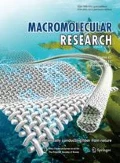Abstract
The aim of this study was to investigate the effect of the Carbopol® hydrogel containing propolis (CHP) on wound healing in a rat model. CHP extracts inhibited nitric oxide production induced by lipopolysaccharide in RAW264.7 cells with a concentration-dependent manner. Wounds were prepared through excision to remove full-thickness skin of rats k]and then were covered with CHP. The covered wounds showed significantly rapid contraction and closure. Histological tissue examination indicated that CHP induced advanced granulation tissue formation and re-epithelialization in the wound. These results indicate that CHP may be helpful for the promotion of wound healing.

Similar content being viewed by others
References
R. Silva-Carvalho, F. Baltazar, and C. Almeida-Aguiar, Evid. Based Complement. Alternat. Med., 2015, 206439 (2015).
F. Fratini, G. Cilia, S. Mancini, and A. Felicioli, Microbiol. Res., 192, 130–141 (2016).
S. Huang, C.-P. Zhang, K. Wang, G.-Q. Li, and F.-L. Hu, Molecules, 19, 19610 (2014).
S.-V. McLennan, J. Bonner, S. Milne, L. Lo, A. Charlton, S. Kurup, J. Jia, D.-K. Yue, and S.-M. Twigg, Wound Repair Regen., 16, 706 (2008).
S.-I. Pillai, P. Palsamy, S. Subramanian, and M. Kandaswamy, Pharm. Biol., 48, 1198 (2010).
S.-A. Eming, T. Krieg, and J.-M. Davidson, J. Invest. Dermatol., 127, 514 (2007).
J.-B. Daleprane and D.-S. Abdalla, Evid. Based Complement. Alternat. Med., 2013, 175135 (2013).
C.-G.-F. Chan, K.-W. Cheung, and D.-M.-Y. Sze, Clinc. Rev. Allerg. Immunol., 44, 262 (2013).
M. Dzialo, J. Mierziak, U. Korzun, M. Preisner, J. Szopa, and A. Kulma, Int. J. Mol. Sci., 17, 160 (2016).
V.-G. Kadajji and G.-V. Betageri, Polymers, 3, 1972 (2011).
N. Chirani, L. Yahia, L. Gritsch, F.-L. Motta, S. Chirani, and S. Fare, J. Biomed. Sci., 4, 1 (2015).
R. A-sasutjarit, A. Sirivat, and P. Vayumhasuwan, Pharm. Res., 22, 2134 (2005).
A. Kaler, A.-K. Mittal, M. Katariya, H. Harde, A.-K. Agrawal, S. Jain, and U.-C. Banerjee, J. Nanopart. Res., 16, 2605 (2014).
D.-K. Asami, Y.-J. Hong, D.-M. Barrett, and A.-E. Mitchell, J. Agric. Food Chem., 51, 1237 (2003).
C.-C. Chang, M.-H. Yang, H.-M. Wen, and J.-C. Chern, J. Food Drug Anal., 10, 178 (2002).
M. Öztürk, F. Aydogmus-Öztürk, M.-E. Duru, and G. Topçu, Food Chem., 103, 623 (2007).
D.-L. Granger, R.-R. Tanintor, K.-S. Boockvar, and Jr J.-B. Hibbs, Methods Ezymol., 268, 142 (1996).
M.-P. Kähkönen, A.-I. Hopia, H.-J. Vuorela, J.-P. Rauha, K. Pihlaja, T.-S. Jujala, and M. Heinonen, J. Agric. Food Chem., 47, 3954 (1999).
L. Aksoy, E. Kolay, Y. Agilönü, Z. Aslan, and M. Kargioglu, Saudi J. Biol. Sci., 20, 235 (2013).
L.-C. Lu, Y.-W. Chen, and C.-C. Chou, Int. J. Food Microbiol., 102, 213 (2005).
S. Stepanovic, N. Antic, I. Dakic, and M. Svabic-Vlahovic, Microbiol. Res., 158, 353 (2003).
Y.-S. Song, E.-H. Park, G.-M. Hur, Y.-S. Ryu, Y.-M. Kim, and C. Jin, J. Ethnopharmacol., 80, 155 (2002).
N. Paulino, C. Teixeira, R. Martins, A. Scremin, V.-M. Ddirsch, A.-M. Vollmar, S.-R. Abreu, S.-L de Castro, and M.-C. Marcucci, Planta Med., 72, 899 (2006).
V.-R. Pasupuleti, L. Sammugam, N. Ramesh, and S.-H. Gan, Oxid. Med. Cell. Longev., 2017, 1 (2017).
R. Gharibi, H. Yeganeh, A. Rezapour-Lactoee, and Z.-M. Hassan, ACS Appl. Mater. Interfaces, 7, 24296 (2015).
S.-J. Kim, M.-H. Lim, I.-K. Chun, and Y.-H. Won, Skin Pharmacol., 10, 200 (1997).
Author information
Authors and Affiliations
Corresponding author
Additional information
Acknowledgments: This research was supported by Basic Science Research Program through the National Research Foundation of Korea (NRF) funded by the Ministry of Education (NRF-2015R1C1A1A02036746 and 2017M2A2A7A0304183 2).
The image from this article is used as the cover image of the Volume 26, Issue 13.
Rights and permissions
About this article
Cite this article
Kim, J., Lee, CM. Transdermal Hydrogel Composed of Polyacrylic Acid Containing Propolis for Wound Healing in a Rat Model. Macromol. Res. 26, 1219–1224 (2018). https://doi.org/10.1007/s13233-019-7014-7
Received:
Revised:
Accepted:
Published:
Issue Date:
DOI: https://doi.org/10.1007/s13233-019-7014-7




